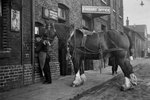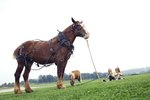
Unlike other draft breeds, you won't usually find a Clydesdale horse out in the fields pulling a plow. Of course, they can do that, but they're more often found in the show ring. Clydesdales, the peacocks of the draft horse world, look great pulling large hitches. That's the reason a certain beer company uses these fancy large horses as an integral part of its advertising and imagery.
History
Originating from Scotland, the breed gets its name from the Clyde River. Known for their exceptional pulling ability, theses horses were initially used not just as farm animals but for pulling loads of freight through the streets of Scottish cities and towns. By the early 19th century, a breed registry was established. The first Clydesdales arrived in North America prior to the Civil War. Today, there are approximately 5,000 Clydesdale worldwide, according to the American Livestock Breeds Conservancy.
Appearance
Standing between 16.2 and 18 hands high at the withers, Clydesdales weigh between 1,600 and 2,400 pounds when full-grown. Although bay -- a brown body with black points on the mane, tail and legs -- is the best-known color, Clydesdales also appear in chestnut, brown, black and roan. The breed's legs contain heavy feathering, or long, silky white hairs. Clydesdales often boast white facial markings such as large blazes, as well some white splashing on the belly. As the British Clydesdale Horse Society puts it, "Male or female, a Clydesdale should look handsome, weighty and powerful."
Feet
As the old horseman's adage says, "No hoof, no horse," but the Clydesdale feet are renowned for their quality. It's not just the size of the foot, although the Clydesdale hooves are larger than other draft breeds. Their hooves are tough and durable. According to the Clydesdale Breeders of the U.S.A., shoes the size of dinner plates are needed for their animals.
Temperament
Large horses require good temperaments. Otherwise, their sheer size makes them difficult to train. Known as the gentle giant, the typical Clydesdale exhibits a willing, kind disposition. He's a smart horse who picks up training relatively easily.
Movement
For a heavy horse, the Clydesdale displays lots of action when he moves. That's why he's such a popular hitch horse. Each hoof rises completely off the ground, so a spectator sees the bottom of the hoof quite clearly as the horse passes by. The Clydesdale displays long, straight strides with pronounced joint flexion.
References
Photo Credits
-
Digital Vision./Digital Vision/Getty Images
Writer Bio
Jane Meggitt has been a writer for more than 20 years. In addition to reporting for a major newspaper chain, she has been published in "Horse News," "Suburban Classic," "Hoof Beats," "Equine Journal" and other publications. She has a Bachelor of Arts in English from New York University and an Associate of Arts from the American Academy of Dramatics Arts, New York City.




